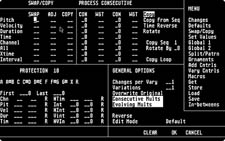Please note: some links on this page are in maintenance.
A sequence of four chamber works written between 1988 and 1991 exploring computer assisted composition using the tools of the MIDI studio.

Between 1988 and 1991 Nigel Morgan created a sequence of four works,
DUO
(trombone/horn and percussion),
TRIO
(violin, clarinet and piano),
QUARTET
(string quartet) and
EDGE
(wind quartet).
These pieces, forming a CD-length concert called TOUCHED BY MACHINE?, were part of a sustained project to explore computer-assisted composition using the tools of the MIDI studio.




TOUCHED BY MACHINE?
– Composition and Performance in the Digital Age is the title of an article by Stephen Travis Pope. It was published in Computer Music Journal: vol 19. No.3. Cambridge MA. MIT Press. The text presents responses from composers who were asked the following questions: How have new technologies changed
the process of composition and performance? What new possibilities are aesthetically and artistically relevant? How do the new tools allow us to use musical material differently?
Nigel Morgan’s answers here focus on the tools of MIDI studio: the computer, its software, MIDI hardware.
How have new technologies changed the process of composition and performance?
What new possibilities are aesthetically and artistically relevant?
How do the new tools allow us to use musical material differently?

from QUARTET for string quartet
Composing the four works that make up TOUCHED BY MACHINE? were undertaken in a spirit of research into techniques, methods and strategies made possible by a tool-kit of software applications, some favouring real-time processes encouraging improvisation, others requiring careful reflection and processing ‘off-line’ before generating, processing or editing material.


PVG and M
Following this experience Nigel Morgan turned almost exclusively to co-developing (with Pekka Tolonen and Janusz Podrazik) the software application Symbolic Composer, a rich programming environment for music based on Common Lisp. The majority of compositions written since 1992 have used this Lisp programming environment starting with Heartstone for wind, brass and percussion with
solo piano.

Aside from the technical aspects of these compositions there is an important extra-musical element to consider. This comes from the composer’s interest in the work of the artist Bridget Riley, in particular her ability to engage the viewer actively in her monochrome paintings and then later her work with colour stripes. In these paintings squares, circles and lines are woven together into an optical symmetry that allows the pictorial space to oscillate and ‘dance’. Riley has described how the source of this approach comes from her mother who was ‘. . . a great looker . . . who constantly described everything she could . . . the play of sunlight on a glass . . . the depth of texture in the sea and sky . . .’ In Riley’s work the abstract shape becomes a living and vibrating expression of the natural world. It is the viewer’s position in, and movement across, the pictorial space that appears to make the image ‘move’ playfully. The music of all the pieces in the TOUCHED BY MACHINE? sequence attempts something of the same, only with sound and the ear rather than the image
and the eye.
Please click on the images above to find out more about each section of TOUCHED BY MACHINE?
